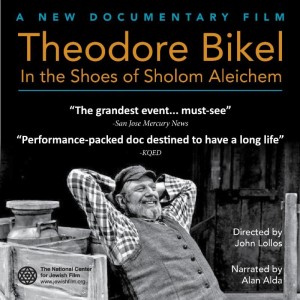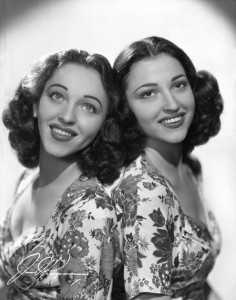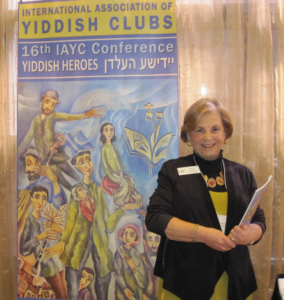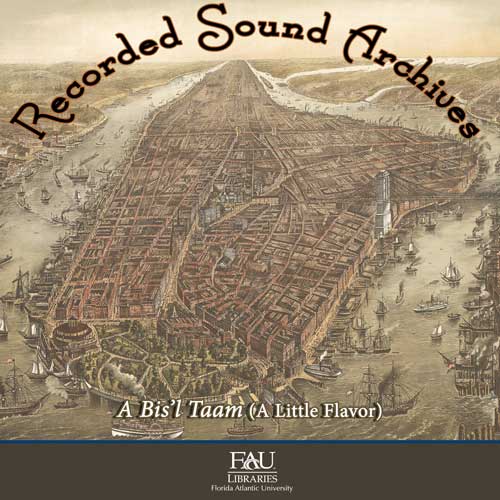 Portraits of two beloved icons–Sholom Aleichem and Theodore Bikel–are woven together in this enchanting new documentary. The two men have much in common: wit, wisdom and talent, all shot through with deep humanity and Yiddishkeit.
Portraits of two beloved icons–Sholom Aleichem and Theodore Bikel–are woven together in this enchanting new documentary. The two men have much in common: wit, wisdom and talent, all shot through with deep humanity and Yiddishkeit.
Theodore Bikel, the unstoppable performer whose career spans more than 150 screen roles (including an Oscar-nominated turn in “The Defiant Ones”) and countless stage and musical productions, is also the foremost interpreter of Sholom Aleichem’s work. Now 90, Bikel has played Tevye the Milkman on stage more than 2,000 times, and he has animated Aleichem’s work through his creation of two celebrated musical plays about the great Russian author. Read More About This…

Bagelman Sisters/Barry Sisters early photo with Claire Barry on the right.
Yiddish music icons, Merna and Claire Barry, entertained generations of Jewish Americans with their jazzy versions of Yiddish songs.
For over 40 years the Bagelman Sisters, later known as the Barry Sisters, were the darlings of Jewish entertainment. Their recordings could be found in almost every Jewish household in the 1950s and 60s. The younger of the two sisters, Merna, passed away in 1976. The older sister, Claire Barry, died on November 22, 2014 in Hollywood, FL at 94. Click here for full NY Times obituary. Read More About This…

RSA Director, Maxine Schackman, at the IAYC conference on Nov. 15 in Boca Raton, FL.
RSA director, Maxine Schackman, told the audience at the International Association of Yiddish Clubs conference in Boca Raton that FAU Libraries has been collecting Judaic recordings since 2002. Read More About This…
 Do you know this person?
Do you know this person?
Clue: He is a Dutch man who was once called the King of Yiddish Music.
Leo Fuld was one of the premier Yiddish performers in America during the 1950’s and 1960’s. Audiences loved to hear him sing Yiddish favorites in a combination of Yiddish and English. They loved his music which evoked the emotions and hardships of the Jewish people. Simply put, audiences loved the truth in his music.
One of his most famous compositions “Vi Ahin Zol lch Geyn? (Where Can I Go?)”, can still wrench the heart. It sold over one and a half million copies worldwide. Leo Fuld not only composed Yiddish songs, he also performed them with great success. His list of recorded hits include: Ich Hab Dich Zu Viel Lieb (I Love You Much Too Much), Wus Geween Ist Geween, My Yiddishe Mama, Zigany Melody. The lyrics to his song, Mazzel, tells us something that we all know….a little luck can make a big difference! Read More About This…
 If you like Jewish music, you will love A Bis’l Taam (A Little Flavor), JSA’s most recent compilation of songs now available on CD.
If you like Jewish music, you will love A Bis’l Taam (A Little Flavor), JSA’s most recent compilation of songs now available on CD.
Recorded from early 20th century 78 rpm phonograph discs the album contains snippets of 21 songs. You will be amazed at the beautiful sound quality and the range of music. Read More About This…
 Portraits of two beloved icons–Sholom Aleichem and Theodore Bikel–are woven together in this enchanting new documentary. The two men have much in common: wit, wisdom and talent, all shot through with deep humanity and Yiddishkeit.
Portraits of two beloved icons–Sholom Aleichem and Theodore Bikel–are woven together in this enchanting new documentary. The two men have much in common: wit, wisdom and talent, all shot through with deep humanity and Yiddishkeit.


